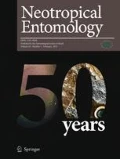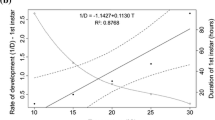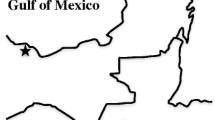Abstract
The life history traits of blow fly Cochliomyia macellaria (Fabricius, 1775) was studied under semi-controlled laboratory conditions at 29.14°C temperature, 72.53% relative humidity, and 12-h photoperiod. The raw data were analyzed based on the age-stage, two-sex life table, considering the development rates among individuals of both sexes. Cochliomyia macellaria survival rate was 0.43 (♂) and 0.40 (♀), while life expectancy was 17.9 (♂) and 20.9 (♀) days, for adult males and females, respectively. The total fecundity was 681.15 eggs/female, with an average of 3.65 batches/female and 199 eggs/batch. The intrinsic rate of increase (r) was 0.327 days−1, the finite rate of population increase (λ) was 3.35 days−1, the mean generation time (T) was 17.15 days, and the net reproduction rate (R 0 ) was 272.46 offspring/individual. The population parameters found here corroborates that C. macellaria population act as a r selected species under laboratory conditions. Additionally, development data and accumulated degree days (ADD) for each stage of C. macellaria are provided and its implications for the forensic use are discussed.






Similar content being viewed by others
References
Abou Zied EM, Gabre R, Chi H (2003) Life table of the australian sheep blow fly Lucilia cuprina (Wiedemann) (Diptera: Calliphoridae). Egypt J Zool 41:29–45
Battán M, Linhares A, Ferradas B, García D (2010) Decomposition and dipteran succession in pig carrion in Central Argentina: ecological aspects and their importance in forensic science. Med Vet Entomol 24:16–25
Baumgartner D, Greenberg B (1985) Distribution and medical ecology of the blow flies (Diptera: Calliphoridae) of Peru. Ann Entomol Soc Am 78:565–587
Begon M, Townsend C, Harper J (2006) Ecology from individuals to ecosystems, Fourth edn. Blackwell Publishing, Oxford, p 738
Bermúdez S, Espinosa J, Cielo A, Clavel F, Subía J, Barrios S, Medianero E (2007) Incidence of myiasis in Panama during the eradication of Cochliomyia hominivorax (Coquerel 1858, Diptera: Calliphoridae) (2002-2005). Mem Inst Oswaldo Cruz 102(6):675–679
Boatright S, Tomberlin J (2010) Effects of temperature and tissue type on the development of Cochliomyia macellaria (Diptera: Calliphoridae). J Med Entomol 47(5):917–923
Bonatto S (1996) Ciclo de vida de Sarconesia chlorogaster (Wiedemann) (Diptera, Calllphoridae, Toxotarsinae), criada sob condições de laboratório em dieta artificial. Rev Bras Zool 13(3):685–707
Bourel B, Callet B, Hédouin V, Gosset D (2003) Flies eggs: a new method for the estimation of short-term post-mortem interval? Forensic Sci Int 135:27–34
Browne L (2001) Quantitative aspects of the regulation of ovarian development in selected anautogenous Diptera: integration of endocrinology and nutrition. Entomol Exp Appl 100(2):137–149
Byrd J, Castner J (2010) Insects of forensic importance. In: Byrd J, Castner J (eds) Forensic entomology: the utility of arthropods in legal investigations, Second edn. Taylor and Francis Group, USA, pp 39–126
Catts E (1992) Problems in estimating the post mortem interval in death investigations. J Agri Entomol 9(4):245–255
Chapman R (1975) The insects: structure and function, Second edn. The English Universities Press Ltd, London XII+819 p
Chi H (1988) Life table analysis incorporating both sexes and variable development rates among individuals. Environ Entomol 17:26–34
Chi H (2009) TWOSEX-MSChart: a computer program for the age-stage, two-sex life table analysis. http://140.120.197.173/Ecology/. Accessed 25 Jun 2015
Chi H, Liu H (1985) Two new methods for the study of insect population ecology. Bull Inst Zool Acad Sin 24:225–240
Clark K, Evans L, Wall R (2006) Growth rates of the blowfly, Lucilia sericata, on different body tissues. Forensic Sci Int 156(2–3):145–149
Dale W, Prudot E (1987) Apuntes sobre la biología de las moscas Calliphoridae en la costa central peruana. Rev Peru Entomol 29:105–111
Defilippo F, Bonilauri P, Dottori M (2013) Effect of temperature on six different developmental landmarks within the pupal stage of the forensically important blowfly Calliphora vicina (Robineau-Desvoidy) (Diptera: Calliphoridae). J Forensic Sci 58(6):1556–4029
Di Rienzo J, Casanoves F, Balzarini M, Gonzalez L, Tablada M, Robledo C (2012) InfoStat versión 2012. Grupo InfoStat, FCA, Universidad Nacional de Córdoba, Argentina http://www.infostat.com.ar. Accessed 19 Feb 2012
El-Shazly M, El-Sherif A, Omar H (1995) A comparative study on the reproductive strategies of a larviparous and an oviparous fly associated with carrion. Bull Soc Entomol Suisse 68:323–330
Ferraz A, Almeida V, De Jesus D, Rotatori G, Nunes R, Proença B, Aguiar-Coelho V, Lessa C (2011) Epidemiological study of myiases in the hospital do Andaraí, Rio de Janeiro, including reference to an exotic etiological agent. Neotrop Entomol 40(3):393–397
Fisher R (1930) The genetic theory of natural selection. Clarendon Press, Oxford 272 p
Gabre R, Adham F, Chi H (2005) Life table of Chrysomya megacephala (Fabricius) (Diptera: Calliphoridae). Acta Oecol 27:179–183
Greenberg B, Varela G, Bornwstein A, Herrnandez H (1963) Salmonella from flies in a Mexican slaughterhouse. Am J Hyg 77:177–183
Hammer O, Harper D, Ryan P (2001) PAST: Palaeontological statistics software package for education and data analysis. Palaeontol Electron 4(1):1–9 Version 2.17c. http://folk.uio.no/ohammer/past. Accessed 03 Feb 2013
Higley L, Haskell N (2001) Insect development and forensic entomology. In: Byrd J, Castner J (eds) Forensic entomology the utility of arthropods in legal investigations. CRC Press, USA, pp 287–300
Holdridge L (2000) Ecología basada en zonas de vida. Quinta reimpresión. Instituto Interamericano de Cooperación Para la Agriculturas, San José 216 p
Iannacone J (2003) Artropofauna de importancia forense en un cadáver de cerdo en el Callao, Perú. Rev. Bras. Zool. 20:85–90
Kaneshrajah G, Turner B (2004) Calliphora vicina larvae grow at different rates on different body tissues. Int J Legal Med 118(4):242–244
Masiero F, Thyssen P (2016) Evaluation of conventional therapeutic methods versus maggot therapy in the evolution of healing of tegumental injuries in Wistar rats with and without diabetes mellitus. Parasitol Res 115:2403–2407
Nassu M, Thyssen P (2015) Evaluation of larval density Cochliomyia macellaria F. (Diptera: Calliphoridae) for therapeutic use in the recovery of tegumentar injuries. Parasitol Res 114:3255–3260
Oliveira T, Vasconcelos S (2010) Insects (Diptera) associated with cadavers at the Institute of Legal Medicine in Pernambuco, Brazil: implications for forensic entomology. Forensic Sci Int 198:97–102
Oliveira-Costa J, Mello-Patiu C (2004) Application of forensic entomology to stimate of the post-mortem interval (PMI) in homicide investigations by the Rio de Janeiro plice Department in Brazil. Aggrawal's Internet J Forensic Med Toxicol 5:440–444
Owings C, Spiegelman C, Tarone A, Tomberlin J (2014) Developmental variation among Cochliomyia macellaria Fabricius (Diptera: Calliphoridae) populations from three ecoregions of Texas, USA. Int J Legal Med 128(4):709–717
Pianka E (1970) On r- and k-selection. Am Nat 104:592–597
Queiroz M, Milward-de-Azevedo E (1991) Técnicas de criação e alguns aspectos da biologia de Chrysomya albiceps (Wiedemann) (Diptera, Calliphoridae), em condições de laboratório. Rev. Bras. Zool. 8(112/3/4):75–84
Rivers D (2015) Heat production by necrophagous fly larvae: implications for forensic entomology. Ann Forensic Res Anal 2:1013
Rueda L, Ortega L, Segura N, Acero A, Bello F (2010) Lucilia sericata strain from Colombia: experimental colonization, life tables and evaluation of two artificial diets of the blowfly Lucilia sericata (Meigen) (Diptera: Calliphoridae), Bogotá, Colombia strain. Biol Res 43:197–203
Sharma R, Garg R, Gaur J (2015) Various methods for the estimation of the post mortem interval from Calliphoridae: a review. Egypt J Forensic Sci 5:1–12
Szyska M, Greenberg B (1984) Immature stages and biology of fifteen species of Peruvian Calliphoridae (Diptera). Ann Entomol Soc Ame 77(5):488–517
Thyssen P (2010) Keys for identification of immature insects. In: Amendt J, Goof M, Campobasso C, Grassberge M (eds) Current concepts in forensic entomology. Springer, Dordrecht, pp 25–42
Vélez M, Wolff M (2008) Rearing five species of Diptera (Calliphoridae) of forensic importance in Colombia in semicontrolled field conditions. Pap Avulsos Zool 48(6):41–47
Acknowledgements
We are grateful to Dr. Hsin Chi for guiding us in the use of the program for analyzing the life table; the last author thanks Tecnológico de Antioquia-Institución Universitaria for the logistical support.
Author information
Authors and Affiliations
Corresponding author
Additional information
Edited by Simão Dias Vasconcelos - UFRPE
Rights and permissions
About this article
Cite this article
Alvarez Garcia, D.M., Pérez-Hérazo, A. & Amat, E. Life History of Cochliomyia macellaria (Fabricius, 1775) (Diptera, Calliphoridae), a Blowfly of Medical and Forensic Importance. Neotrop Entomol 46, 606–612 (2017). https://doi.org/10.1007/s13744-017-0496-0
Received:
Accepted:
Published:
Issue Date:
DOI: https://doi.org/10.1007/s13744-017-0496-0




